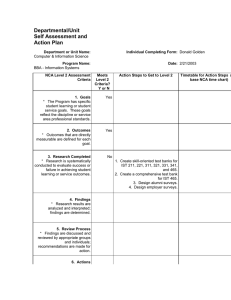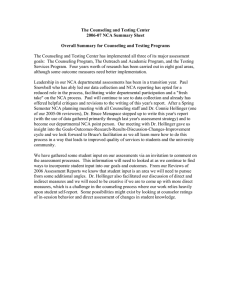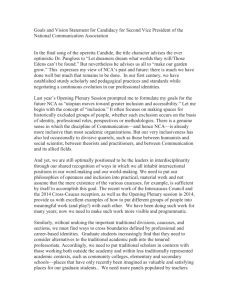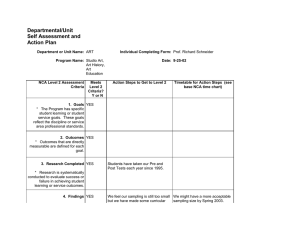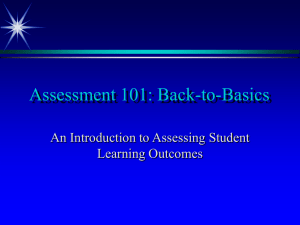Dimensionality Reduction for Speech Recognition Using
advertisement
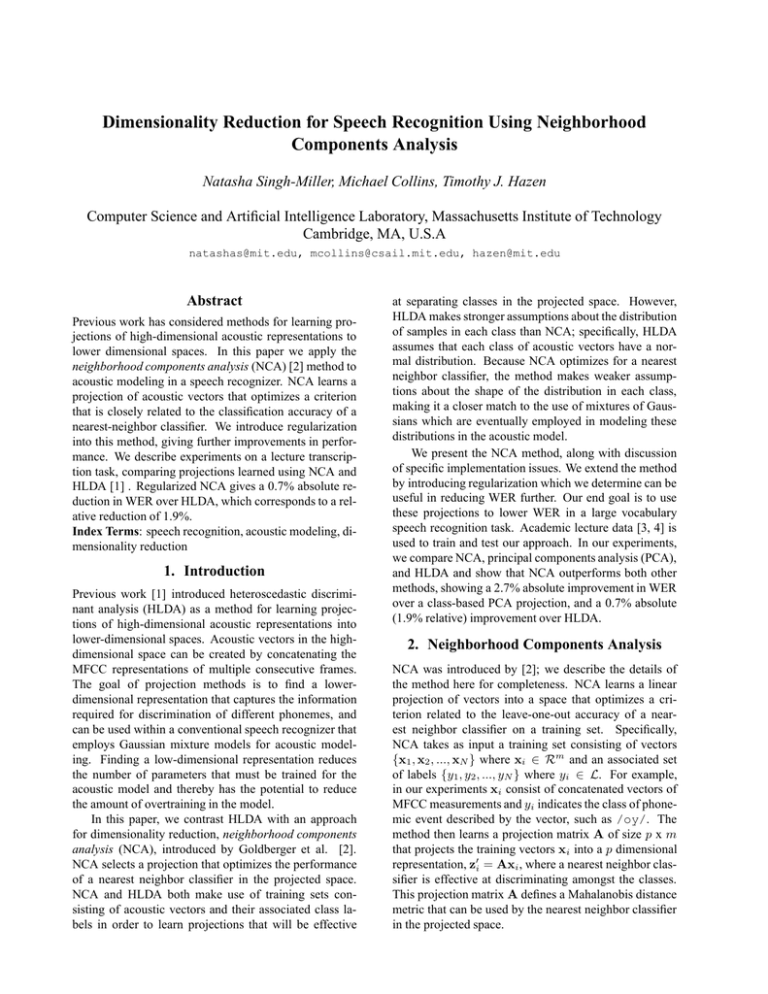
Dimensionality Reduction for Speech Recognition Using Neighborhood
Components Analysis
Natasha Singh-Miller, Michael Collins, Timothy J. Hazen
Computer Science and Artificial Intelligence Laboratory, Massachusetts Institute of Technology
Cambridge, MA, U.S.A
natashas@mit.edu, mcollins@csail.mit.edu, hazen@mit.edu
Abstract
Previous work has considered methods for learning projections of high-dimensional acoustic representations to
lower dimensional spaces. In this paper we apply the
neighborhood components analysis (NCA) [2] method to
acoustic modeling in a speech recognizer. NCA learns a
projection of acoustic vectors that optimizes a criterion
that is closely related to the classification accuracy of a
nearest-neighbor classifier. We introduce regularization
into this method, giving further improvements in performance. We describe experiments on a lecture transcription task, comparing projections learned using NCA and
HLDA [1] . Regularized NCA gives a 0.7% absolute reduction in WER over HLDA, which corresponds to a relative reduction of 1.9%.
Index Terms: speech recognition, acoustic modeling, dimensionality reduction
1. Introduction
Previous work [1] introduced heteroscedastic discriminant analysis (HLDA) as a method for learning projections of high-dimensional acoustic representations into
lower-dimensional spaces. Acoustic vectors in the highdimensional space can be created by concatenating the
MFCC representations of multiple consecutive frames.
The goal of projection methods is to find a lowerdimensional representation that captures the information
required for discrimination of different phonemes, and
can be used within a conventional speech recognizer that
employs Gaussian mixture models for acoustic modeling. Finding a low-dimensional representation reduces
the number of parameters that must be trained for the
acoustic model and thereby has the potential to reduce
the amount of overtraining in the model.
In this paper, we contrast HLDA with an approach
for dimensionality reduction, neighborhood components
analysis (NCA), introduced by Goldberger et al. [2].
NCA selects a projection that optimizes the performance
of a nearest neighbor classifier in the projected space.
NCA and HLDA both make use of training sets consisting of acoustic vectors and their associated class labels in order to learn projections that will be effective
at separating classes in the projected space. However,
HLDA makes stronger assumptions about the distribution
of samples in each class than NCA; specifically, HLDA
assumes that each class of acoustic vectors have a normal distribution. Because NCA optimizes for a nearest
neighbor classifier, the method makes weaker assumptions about the shape of the distribution in each class,
making it a closer match to the use of mixtures of Gaussians which are eventually employed in modeling these
distributions in the acoustic model.
We present the NCA method, along with discussion
of specific implementation issues. We extend the method
by introducing regularization which we determine can be
useful in reducing WER further. Our end goal is to use
these projections to lower WER in a large vocabulary
speech recognition task. Academic lecture data [3, 4] is
used to train and test our approach. In our experiments,
we compare NCA, principal components analysis (PCA),
and HLDA and show that NCA outperforms both other
methods, showing a 2.7% absolute improvement in WER
over a class-based PCA projection, and a 0.7% absolute
(1.9% relative) improvement over HLDA.
2. Neighborhood Components Analysis
NCA was introduced by [2]; we describe the details of
the method here for completeness. NCA learns a linear
projection of vectors into a space that optimizes a criterion related to the leave-one-out accuracy of a nearest neighbor classifier on a training set. Specifically,
NCA takes as input a training set consisting of vectors
{x1 , x2 , ..., xN } where xi ∈ Rm and an associated set
of labels {y1 , y2 , ..., yN } where yi ∈ L. For example,
in our experiments xi consist of concatenated vectors of
MFCC measurements and yi indicates the class of phonemic event described by the vector, such as /oy/. The
method then learns a projection matrix A of size p x m
that projects the training vectors xi into a p dimensional
representation, z0i = Axi , where a nearest neighbor classifier is effective at discriminating amongst the classes.
This projection matrix A defines a Mahalanobis distance
metric that can be used by the nearest neighbor classifier
in the projected space.
d(xi , xj ) = (Axi − Axj )T (Axi − Axj )
By selecting p < m, we can learn a lower dimensional
representation of the original acoustic vectors.
The goal of the method is to learn a projection A that
maximizes the accuracy of a nearest neighbor classifier.
In order to define a differentiable optimization criterion,
the method makes use of “soft-neighbor” assignments instead of directly using the k nearest neighbors. Specifically, each point j in the training set has a probability
pij of assigning its label to a point i that decays as the
distance between points i and j increase.
exp(−||Axi − Axj ||2 )
, pii = 0
pij = P
2
k6=i exp(−||Axi − Axk || )
The method attempts to maximize the expected number of points correctly classified in a leave-one-out setting over the training set. This optimization criterion can
be defined using the soft-neighbor assignments. First a
quantity pi is defined that denotes the probability of a
point i being assigned the correct class label.
X
pi =
pij
j∈Ci
Ci = {j|yj = yi }
The final optimization criterion f (A) can then be defined
simply as the sum of the probabilities of classifying each
X
point correctly.
f (A) =
pi
i
This criterion gives rise to a gradient rule that can be
used to optimize the matrix A. (Note that xij is shorthand for xi − xj .)
X
X
X
∂f
p i
pij xij xTij
= 2A
pik xik xTik −
∂A
i
k
j∈Ci
This function can be optimized using a number of gradient methods, such as stochastic gradient ascent, or conjugate gradient ascent. Note that the function f (A) is
not convex, so care needs to taken when initializing the
matrix A in order to avoid sub-optimal solutions.
2.1. Computational Performance
The calculation of the above gradient can be computationally quite expensive. Calculating the soft-neighbor
probabilities alone requires O(N 2 p) calculations. However, many of these probabilities will be very close to
zero, allowing us to truncate the gradient calculation.
Additionally, we can reduce the amount of computation by re-arranging terms of the gradient as follows.
X
X
X
∂f
pi
pij (Axij )xTij
=2
pik (Axik )xTik −
∂A
i
k
j∈Ci
In our experiments we optimize f (A) using conjugate gradient ascent, which we parallelize across several
machines.
2.2. Regularization
We can introduce regularization into the NCA optimization criterion in order to alleviate a few possible problems with the method. Regularization can help counteract over-fitting effects we might see with the training
data. The other problem we seek to address with regularization is specifically related to the definition of the
soft-neighbor assignments used by the method. Because
soft-neighbor assignments pij decay very rapidly with
distance, as the magnitude of A increases the effective
number of nearest neighbors influencing the labeling of a
point decreases. If the magnitude of A grows sufficiently
large, the method might simply consider just the one closest neighbor, which could lead to a quite suboptimal projection of the data. We therefore introduce the following
regularized version of the optimization function where C
is a constant chosen by optimizing the leave-one-out performance over a development set.
X
1 X
freg (A) =
A2j,k
pi − C
N i
j,k
where Aj,k indicates the element at the jth row and kth
column of matrix A.
3. Experiments
We compare NCA and HLDA using speech recognition
experiments on academic lectures [3, 4]. We train the
HLDA projection using the code provided by [1] for
HLDA using full covariance matrices. For training we
have 121 hours of speech collected from a wide variety
of lectures predominantly obtained from the MIT World
collection [5, 6]. For testing we have 6 hours of similar
data. We use the SUMMIT recognizer [7] in our experiments.
Each acoustic sample is represented using a 112dimensional feature vector, consisting of the concatenation of eight 14-dimensional feature vectors. Each of
these vectors contain 14 MFCC measurements taken at
eight telescoped time intervals around the point of the
acoustic sample.
The training set was manually transcribed, with time
alignments of words and phonetic events obtained via
forced transcription using our baseline recognizer. From
the forced transcriptions, labels for each acoustic feature
vector are extracted. These labels correspond to 1837
phonetic classes including context independent phone internal labels (e.g. /f/ or /ae/) and diphone transition
labels (e.g. /f/ -> /ae/ or /s/ -> /t/). In our
experiments, we make use of 53 context-independent internal phone classes only. We use a small portion of this
data, 500 samples from each of 53 phonemic classes, to
WER vs. number of projected dimensions
43
NCA
HLDA
42
WER
41
40
39
PCA
HLDA, all training data
HLDA, 500 samples per class
NCA, 500 samples per class
NCA (regularized), 500 samples per class
WER
38.8
36.8
37.1
36.3
36.1
38
37
36
20
30
40
50
60
70
80
number of dimensions
90
100
110
120
Figure 1: WER of HLDA and NCA on a test set for several different dimensionalities.
train a projection using the NCA method. These samples
are randomly selected and come from a number of different speakers. To train the HLDA projection we use all of
the training data across the 53 phonemic classes, around
4 million samples.
Because the optimization function for NCA is nonconvex, care needs to be taken when initializing A. In
our experiments, we initialize the matrix randomly for
both the NCA and regularized NCA projections.
3.1. Speech Recognition
Our end goal is to use NCA in order to reduce speech
recognition word error rates. Because our recognizer
employs mixtures of Gaussians with diagonal covariance matrixes, and because we model 1837 instead of
53 classes used to train the projections, we apply a
class-based PCA after learning NCA and HLDA. This
class-based whitening transform is performed by applying PCA to a covariance matrix obtained by pooling the
covariances of the individual phonetic classes. We compare the WER achieved by both the unregularized version
of NCA and HLDA for a number of dimensions in the
projected space in Figure 1. As the number of dimensions is increased, initially large improvements in WER
are achieved for both methods, but these level-off quickly
at around 40 dimensions. The minimal WER achieved by
NCA occurs at 50 dimensions. As the number of dimensions increases beyond 90, the performance of the recognizer begins to deteriorate, indicating an over-training
effect. A similar trend is seen with the HLDA method,
with optimal performance achieved at 40 and 50 dimensional projections.
In Table 1 we compare the performance of the recognizer using class-based PCA, HLDA, NCA, and the
regularized version of NCA for 50-dimensional projections. Regularized NCA achieves a large improvement
over classed-PCA alone of 2.7%, and a significant improvement over HLDA as well of 0.7% (1.9% relative
improvement). Regularization also improves the performance of NCA, with the regularized method achieving an
Table 1: Word error rate of recognizer using PCA,
HLDA, NCA, and regularized NCA to learn 50 dimensional projections.
improvement of 0.2% over the baseline NCA method.
We additionally experimented with increasing the
number of data points per class used to train NCA to 1000
and 5000. These experiments led to neglible differences
in speech recognition WER.
3.2. Discussion
By looking at the classification accuracy achieved in a
kNN setting using both HLDA and regularized NCA,
we can identify some of the differences between the
two methods. We can calculate the accuracy of a kNN
classifier on a test set of acoustic samples (i.e. a set
of samples not used to train the NCA or HLDA projections). The classification performance of the internal phonemic classes ordered by reduction in error rate
achieved using regularized NCA are shown in Table 2.
A 50-dimensional projection is learned for both regularized NCA and HLDA and both are trained with 500
samples from each of the 53 internal phonemic classes.
NCA achieves large improvements in classification accuracy across almost all the phonemic classes.
Another fact to note is that while the kNN performance of NCA and HLDA are very different, the difference in recognition performance of the two methods in
terms of WER is not as large. This suggests that large
increases in kNN performance does not necessarily mean
large improvements in WER. A direction for future work
would be to try to more directly employ the kNN framework to acoustic modeling, as there may be a mismatch
between the NCA framework and the mixture of Gaussians employed by the acoustic model.
4. Related Work
There are several alternatives to HLDA that also learn discriminative projections. In [8], an alternative to HLDA
is presented that optimizes a minimim phoneme error
(MPE) criterion. This type of discriminative projection
can also be used for speaker adaptation [9]. One problem with NCA is that because the optimization function
is non-convex, it is easy to converge to local optima. An
alternative method to NCA [10] presents a convex optimization function related to NCA that may help solve this
problem.
Phoneme
/epi/
/em/
/ah fp/
/g/
/b/
/pcl/
/zh/
/p/
/jh/
/uw/
/oy/
/sh/
/w/
/ey/
/tcl/
/y/
/ay/
/uh/
/axr/
/v/
/en/
/d/
/z/
/f/
/ch/
/ng/
/k/
/dx/
/th/
/dh/
/t/
/ae/
/aw/
/hh/
/dcl/
/bcl/
/ao/
/iy/
/gcl/
/er/
/el/
/l/
/ow/
/r/
/ih/
/eh/
/aa/
/ah/
/n/
/ax/
/m/
/kcl/
/s/
NCA Acc.
88.60
79.00
72.80
77.80
80.40
63.40
78.00
67.80
55.00
56.60
51.80
67.00
72.20
62.40
49.60
67.20
48.00
58.20
56.00
53.60
55.60
46.40
56.40
63.80
51.00
59.40
62.20
49.60
52.40
55.80
53.40
37.40
39.40
54.20
39.20
50.00
45.20
55.40
42.00
43.40
66.80
25.40
31.80
40.40
32.60
31.80
30.00
27.20
39.00
25.60
31.60
45.20
57.20
HLDA Acc.
62.40
56.60
48.80
58.80
66.40
39.80
65.20
50.00
34.20
37.20
30.60
52.60
60.40
46.60
28.80
54.40
28.40
42.60
40.20
37.00
40.60
29.00
43.00
52.80
37.00
48.00
52.40
36.60
40.60
45.80
43.40
24.40
27.60
45.40
27.80
41.80
36.40
48.40
33.00
35.20
62.00
14.80
22.80
33.00
25.40
24.60
23.40
21.20
34.20
20.60
27.60
43.20
57.40
% Red. in Err.
69.68
51.61
46.88
46.12
41.67
39.20
36.78
35.60
31.61
30.89
30.55
30.38
29.80
29.59
29.21
28.07
27.37
27.18
26.42
26.35
25.25
24.51
23.51
23.31
22.22
21.92
20.59
20.50
19.87
18.45
17.67
17.20
16.30
16.12
15.79
14.09
13.84
13.57
13.43
12.65
12.63
12.44
11.66
11.04
9.65
9.55
8.62
7.61
7.29
6.30
5.52
3.57
-0.47
Table 2: Accuracy of a kNN classifier on a test set of acoustic
vectors with their associated phonemic labels. Vectors are first
projected into a 50-dimensional space using HLDA or regularized NCA trained on a training set of 500 points per class.
HLDA has also been effectively applied to speaker
adaptation [11, 12]. For a single speaker, HLDA
will most likely perform better than in the speakerindependent projections we learn here because multiple
speakers can introduce a high amount of variability in
the data. Specifically, the Gaussian assumption made by
HLDA may be more likely to hold for a single speaker.
When training a projection for a single speaker, it is possible that some of the gains seen when using NCA instead
of HLDA would diminish.
5. Conclusion and Future Work
We have shown that NCA can deliver significant improvements in speech recognition WER over PCA and
HLDA. However NCA has drawbacks, including computational cost and a non-convex optimization function.
Efficient online methods of optimizing the NCA criterion should be investigated. Additionally, future work
can compare NCA against similar methods with a convex optimization function. Finally, there is a mismatch
between the nearest neighbor framework used by NCA
and the mixture of Gaussians used by the recognizer. A
more direct application of the NCA framework within the
recognizer is a promising area for future exploration.
6. References
[1] N. Kumar, Investigation of silicon auditory models and
generalization of linear discriminant analysis for improved speech recognition, Ph.D. thesis, Johns Hopkins
University, Baltimore, Maryland, 1997.
[2] J. Goldberger, S. Roweis, G. Hinton, and R. Salakhutdinov, “Neighbourhood components analysis,” in Advances
in Neural Information Processing Systems 17, L. K. Saul,
Y. Weiss, and L. Bottou, Eds. 2005, pp. 513–520, MIT
Press.
[3] J. Glass, T. J. Hazen, L. Hetherington, and C. Wang,
“Analysis and processing of lecture audio data: Preliminary investigations,” in HLT-NAACL 2004 Workshop on
Interdisciplinary Approaches to Speech Indexing and Retrieval, 2004, pp. 9–12.
[4] A. Park, T. J. Hazen, and J. R. Glass, “Automatic processing of audio lectures for information retrieval: Vocabulary selection and language modeling,” in International
Conference on Acoustics, Speech, and Signal Processing,
2004, pp. 497–500.
[5] “Mit open course ware,” . http://ocw.mit.edu.
[6] “Mit world,” . http://mitworld.mit.edu.
[7] J. Glass, “A probabilistic framework for segment-based
speech recognition,” Computer, Speech, and Language,
vol. 17, no. 2-3, pp. 137–152, 2003.
[8] B. Zhang and S. Matsoukas, “Minimum phoneme error based heteroscedastic linear discriminant analysis for
speech recognition,” in International Conference on
Acoustics, Speech, and Signal Processing, 2005, pp. 925–
928.
[9] L. Wang and P.C. Woodland, “MPE-based discriminative
linear transform for speaker adaptation,” in International
Conference on Acoustics, Speech, and Signal Processing,
2004, pp. 321–324.
[10] A. Globerson and S. Roweis, “Metric learning by collapsing classes,” in Advances in Neural Information Processing Systems 18, Y. Weiss, B. Scholkopf, and J. Platt, Eds.
2006, pp. 513–520, MIT Press.
[11] G. Saon, G. Zweig, and M. Padmanabhan, “Linear feature
space projections for speaker adaptation,” in International
Conference on Acoustics, Speech, and Signal Processing,
2001, pp. 325–328.
[12] S. Matsoukas and R. Schwartz, “Improved speaker adaptation using speaker dependent feature projections,” in
Workshop on Automatic Speech Recognition and Understanding, 2003, pp. 273–278.
